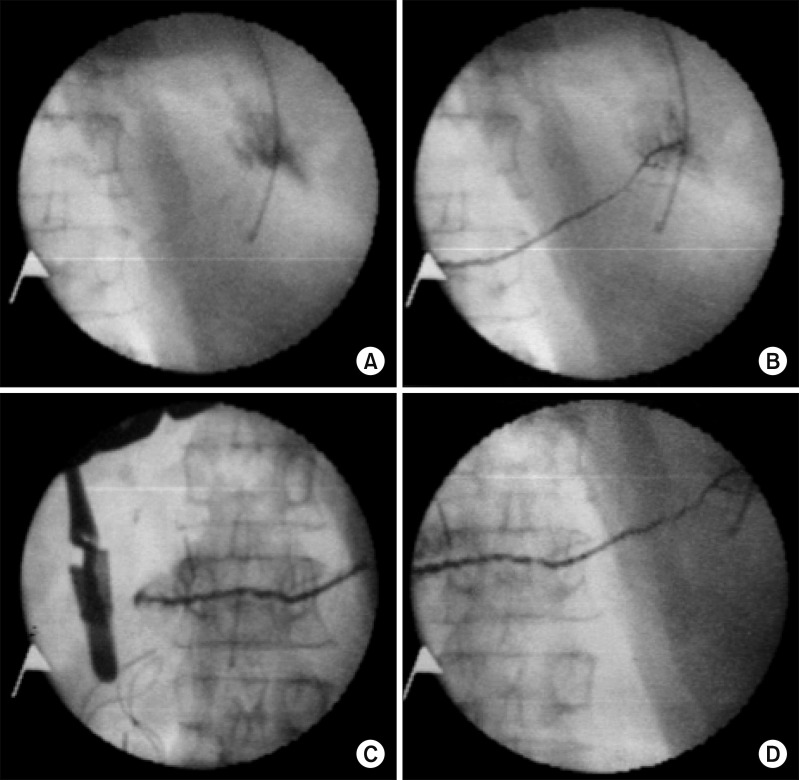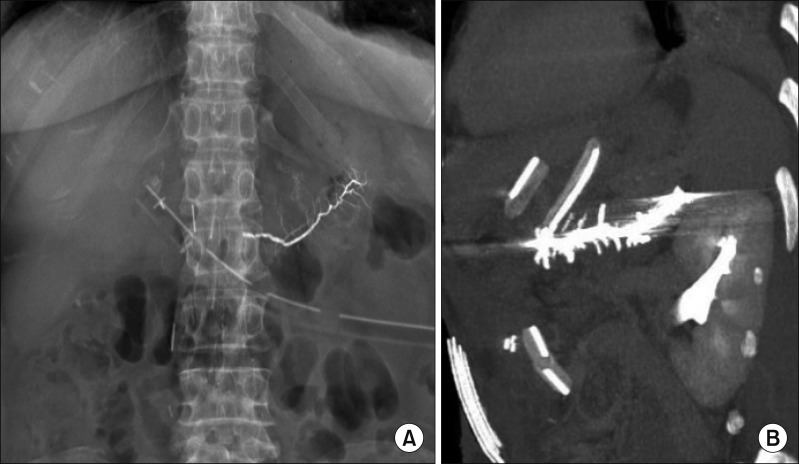Ann Hepatobiliary Pancreat Surg.
2018 Aug;22(3):248-252. 10.14701/ahbps.2018.22.3.248.
How to prevent the postoperative pancreatic fistula with an ethylene vinyl alcohol copolymer (Onyx®): A proposal of a new technique
- Affiliations
-
- 1Oncological and General Surgery Unit, “St. Giuseppe Moscati†Hospital of National Relevance and High Specialty, Avellino, Italy. crafa@tiscali.it
- 2Department of Radiology, “St. Giuseppe Moscati†Hospital of National Relevance and High Specialty, Avellino, Italy.
- KMID: 2420613
- DOI: http://doi.org/10.14701/ahbps.2018.22.3.248
Abstract
- BACKGROUNDS/AIMS
Despite the advances in identifying risk factors, improving operative technique, and postoperative patient care, pancreatic leakage after pancreatic resection remains a highly debated topic. The aim of this study is to describe our technique and our initial experience with the intraoperative embolization of the main pancreatic duct with an Ethylene Vinyl Alcohol Copolymer (Onyx®).
METHODS
Two patients of 63 and 64 years underwent pancreaticoduodenectomy for a cholangiocarcinoma of the extrahepatic bile duct and a pancreatic adenocarcinoma, respectively. At the time of pancreatic parenchyma resection, a Wirsung duct was identified and catheterized. A wirsungography was done and then, embolization with Onyx® was carried out under fluoroscopic control.
RESULTS
Neither of the patients developed a postoperative pancreatic fistula. They were discharged to home on the 17th and 18th postoperative day, respectively. At the last follow-up, no recurrence was found. The two patients became diabetics; both needed the support of supplementary pancreatic enzymes.
CONCLUSIONS
To our knowledge, we are the first to describe this technique, which seems safe and reliable. Studies on this subject with more patients are needed to confirm the validity of this procedure.
MeSH Terms
Figure
Reference
-
1. Zhang H, Zhu F, Shen M, Tian R, Shi CJ, Wang X, et al. Systematic review and meta-analysis comparing three techniques for pancreatic remnant closure following distal pancreatectomy. Br J Surg. 2015; 102:4–15. PMID: 25388952.
Article2. Xiong JJ, Tan CL, Szatmary P, Huang W, Ke NW, Hu WM, et al. Meta-analysis of pancreaticogastrostomy versus pancreaticojejunostomy after pancreaticoduodenectomy. Br J Surg. 2014; 101:1196–1208. PMID: 25042895.
Article3. Bassi C, Marchegiani G, Dervenis C, Sarr M, Abu Hilal M, Adham M, et al. The 2016 update of the International Study Group (ISGPS) definition and grading of postoperative pancreatic fistula: 11 years after. Surgery. 2017; 161:584–591. PMID: 28040257.4. Gouma DJ, van Geenen RC, van Gulik TM, de Haan RJ, de Wit LT, Busch OR, et al. Rates of complications and death after pancreaticoduodenectomy: risk factors and the impact of hospital volume. Ann Surg. 2000; 232:786–795. PMID: 11088073.
Article5. Vollmer CM Jr, Sanchez N, Gondek S, McAuliffe J, Kent TS, Christein JD, et al. A root-cause analysis of mortality following major pancreatectomy. J Gastrointest Surg. 2012; 16:89–102. discussion 102-103. PMID: 22065319.
Article6. Schulick RD, Yoshimura K. Stents, glue, etc.: is anything proven to help prevent pancreatic leaks/fistulae? J Gastrointest Surg. 2009; 13:1184–1186. PMID: 19399562.
Article7. Di Carlo V, Chiesa R, Pontiroli AE, Carlucci M, Staudacher C, Zerbi A, et al. Pancreatoduodenectomy with occlusion of the residual stump by Neoprene injection. World J Surg. 1989; 13:105–110. discussion 110-101. PMID: 2543144.
Article8. Tran K, Van Eijck C, Di Carlo V, Hop WC, Zerbi A, Balzano G, et al. Occlusion of the pancreatic duct versus pancreaticojejunostomy: a prospective randomized trial. Ann Surg. 2002; 236:422–428. discussion 428. PMID: 12368670.9. Suc B, Msika S, Fingerhut A, Fourtanier G, Hay JM, Holmières F, et al. Temporary fibrin glue occlusion of the main pancreatic duct in the prevention of intra-abdominal complications after pancreatic resection: prospective randomized trial. Ann Surg. 2003; 237:57–65. PMID: 12496531.10. Alfieri S, Quero G, Rosa F, Di Miceli D, Tortorelli AP, Doglietto GB. Indications and results of pancreatic stump duct occlusion after duodenopancreatectomy. Updates Surg. 2016; 68:287–293. PMID: 27631168.
Article11. Martin I, Au K. Does fibrin glue sealant decrease the rate of anastomotic leak after a pancreaticoduodenectomy? Results of a prospective randomized trial. HPB (Oxford). 2013; 15:561–566. PMID: 23458447.
Article12. Cheng Y, Ye M, Xiong X, Peng S, Wu HM, Cheng N, et al. Fibrin sealants for the prevention of postoperative pancreatic fistula following pancreatic surgery. Cochrane Database Syst Rev. 2016; 2:CD009621. PMID: 26876721.
Article13. Adamus Nürnberg R, Uder Erlangen M, Kleinschmidt T, Detmar K, Bolte R, Stein H, et al. Embolization of acute abdominal and thoracic hemorrhages with ethylene vinyl alcohol copolymer (onyx): initial experiences with arteries of the body trunk. Rofo. 2010; 182:900–904. PMID: 20725878.14. Eberhardt KM, Treitl M, Sadeghi-Azandaryani M. An endovascular technique for treatment of high-risk iatrogenic aortic pseudoaneurysms with the ethylene vinyl alcohol copolymer onyx and aortic stent grafting. Rofo. 2012; 184:1163–1165. PMID: 23154857.
Article15. Kyokane T, Nagino M, Oda K, Nimura Y. An experimental study of selective intrahepatic biliary ablation with ethanol. J Surg Res. 2001; 96:188–196. PMID: 11266272.
Article16. Uller W, Müller-Wille R, Loss M, Hammer S, Schleder S, Goessmann H, et al. Percutaneous management of postoperative bile leaks with an ethylene vinyl alcohol copolymer (onyx). Rofo. 2013; 185:1182–1187. PMID: 23860801.
Article17. Gaujoux S, Cortes A, Couvelard A, Noullet S, Clavel L, Rebours V, et al. Fatty pancreas and increased body mass index are risk factors of pancreatic fistula after pancreaticoduodenectomy. Surgery. 2010; 148:15–23. PMID: 20138325.
Article18. Callery MP, Pratt WB, Kent TS, Chaikof EL, Vollmer CM Jr. A prospectively validated clinical risk score accurately predicts pancreatic fistula after pancreatoduodenectomy. J Am Coll Surg. 2013; 216:1–14. PMID: 23122535.
Article19. Ramacciato G, Mercantini P, Petrucciani N, Nigri GR, Kazemi A, Muroni M, et al. Risk factors of pancreatic fistula after pancreaticoduodenectomy: a collective review. Am Surg. 2011; 77:257–269. PMID: 21375833.20. Figueras J, Sabater L, Planellas P, Muñoz-Forner E, Lopez-Ben S, Falgueras L, et al. Randomized clinical trial of pancreaticogastrostomy versus pancreaticojejunostomy on the rate and severity of pancreatic fistula after pancreaticoduodenectomy. Br J Surg. 2013; 100:1597–1605. PMID: 24264781.
Article
- Full Text Links
- Actions
-
Cited
- CITED
-
- Close
- Share
- Similar articles
-
- Utility of fistula risk score in assessing the risk of postoperative pancreatic fistula occurrence and other significant complications after different types of pancreatic neuroendocrine tumor resections
- Helical coils augment embolization of the middle meningeal artery for treatment of chronic subdural hematoma: A technical note
- High dose exposures of vinyl acetate induce neoplastic transformation of human epithelial cells in culture
- Evaluation of Enodvascular Treatment for Intracranial AVMs Using MRI
- Utilization of end to side inverted mattress pancreaticojejunostomy for Duval procedure: A case report



